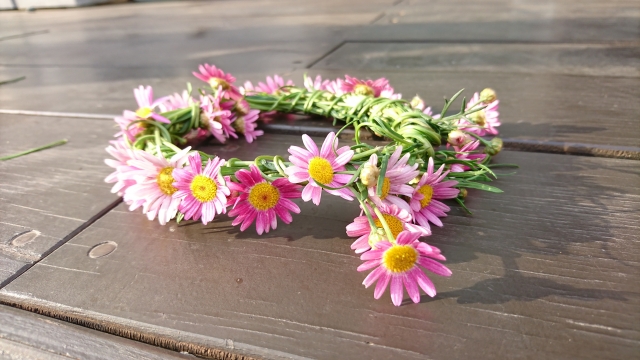*Please scroll down for the English version.
矢ヶ崎紘子(AMOR編集部)
地中海、アフリカとイタリアの間の透明な水に浮かぶランペドゥーザ島は、海難事故が頻繁に起こる海域にあり、ヨーロッパに向けて命がけで出発したアフリカの難民が、不幸にして多数犠牲になっている場所でもあります。2013年7月、就任直後の教皇フランシスコがそのランペドゥーザ島を訪れ、誰も悼むことのなかった人々のために、白い花輪を海に投げたという話を聞きました。花は生命、輪は永遠の象徴でしょう。この話を思い出すと、地中海の青さと白い花の美しい対比が喪の印であることが思われ、どういうわけか涙を催します。
教皇ご自身が移民の子孫であり、このような移住者の苦労がひとごとではないという事情もあとで知りました。わたしたちは苦労や、悲しみや、寂しさなど、同じ種類の苦痛をいだく人々と結びつくことがあります。苦痛を分かち合うということは、とても深い結びつきを産みます。白い花輪は、苦痛を抱きしめながら、愛情をもって他者を記憶することの象徴であるように思われます。
昔の本を読みながら、人間が神の像であるということについてしばしば考えます。人間はこの世界全体を自分の中にもっていますが、同時に、造られた世界を超えた、神に似た存在でもあるのです。4世紀の聖人マクリナは、弟ニュッサのグレゴリオスの著作『魂と復活について』の中でこう述べています。神を太陽とすると、人間は光を反射して輝くガラスの破片のようなものであると。とすれば、わたしたちの記憶は、煤で覆われているとしても、何らかの意味で神の記憶の映しであることにならないでしょうか。花輪をささげて難民を記憶するという教皇の身振りは、ただ人間同士を結びつけただけでなく、忘れられていた人々が永遠に神に記憶されていることを知らせることでもあったように思われます。
 聖職者の役割は信徒を神に結びつけることですが、神の像である人間であることそのものが、世界を神に結びつけるという聖職者のような性質を持っています。私たちは、自分の記憶と行動を意識的に使うことで、世間で忘れられた人々が神の記憶の中に記されているというメッセージを伝えることができるでしょう。時には、「あなたのために祈っています」という普段の挨拶が、教皇の花輪のように大きな慰めになることでしょう。
聖職者の役割は信徒を神に結びつけることですが、神の像である人間であることそのものが、世界を神に結びつけるという聖職者のような性質を持っています。私たちは、自分の記憶と行動を意識的に使うことで、世間で忘れられた人々が神の記憶の中に記されているというメッセージを伝えることができるでしょう。時には、「あなたのために祈っています」という普段の挨拶が、教皇の花輪のように大きな慰めになることでしょう。
The White Wreath of the Lampedusa Island: On Pope Francis’ visit to Japan
Hiroko Yagasaki
The Lampedusa Island, located on the clear Mediterranean Sea between Africa and Italy, is so a difficult region where frequent accidents happen that many African refugees desperately departed to Europe are unfortunately killed. On July 2013, the new pope Francis visited the Island to toss a white wreath into the sea for those who have never been mourned, I heard. The flower symbolizes life, so the circle eternity. This story brings tears to my eyes whenever I remember it, imaging the beautiful contrast of the Mediterranean blue and white flowers was a symbol of grief.
Later I came to know that Pope Francis himself is a descendant of emigrants and he could not be indifferent to such hardship. We are often connected to those who have the same kinds of pain: hardship, sadness and loneliness. Sharing pain generates so deep a connection. Then the white wreath is a symbol of affectionate remembrance of the others, embracing the pain.
Reading classics, I often think over the human being as the image of God. We human contain the whole world in ourselves, but at the same time, we are being the likeness of God transcending the created world. Macrina, a saint in the 4th century, in "On the Soul and the Resurrection", a work of her brother St. Gregory of Nyssa, said: suppose liken God to the Sun, the human being is like a piece of glass reflecting sunlight. Then, it results that, in a sense, our memory reflects God's memory. The gesture of Pope dedicating the wreath seems to not only connect human beings but also declare that the forgotten people are in the memory of God eternally.
If the role of the clergy is to tie the believers to God, being human, the image of God, itself has a kind of clerical nature, that ties this world to God. We can communicate messages that people forgotten in society are written in God’s memory with the conscious use of memory and action. Sometimes the common greeting “I pray for you” will bring a great consolation like the wreath of Pope Francis.










